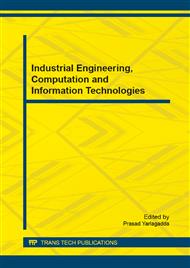[1]
K. T. Hsieh and B. K. Kim. 3D Modeling of Sliding Electrical Contact[J]. IEEE Transactions On Magnetics, 1997, 33(1): 237-239.
DOI: 10.1109/20.559961
Google Scholar
[2]
Thomas G. Engel, Jesse M. Neri, and Michael J. Veracka. Characterization of the Velocity Skin Effect in the Surface Layer of a Railgun Sliding Contact[J]. IEEE Transactions On Magnetics, 2007, 44(17): 1837-1844.
DOI: 10.1109/tmag.2008.922310
Google Scholar
[3]
M. Ghassemi and Y. M. Barsi. Effect of liquid film (Indium) onthermal and electromagnetic distribution of an electromagnetic launcher with new design[J]. IEEE Transactions On Magnetics, 2005, 41(1), 408–413.
DOI: 10.1109/tmag.2004.838759
Google Scholar
[4]
M. Ghassemi, Y. Molayi, and M. H. Hamedi. Analysis Of Force Distribution Acting Upon The Rails And The Armature And Prediction Of Velocity With Time In An Electromagnetic Launcher With New Method[J]. IEEE Transactions On Magnetics, 2007, 43(1): 132-136.
DOI: 10.1109/tmag.2006.887645
Google Scholar
[5]
Yan Dengjun, LIU Ruifang, HU Minqiang, HAN Jingdong. A New Method To Deal With The Motion Problem in Electromagnetic Field Finite Element Analysis[J]. Proceedings of the CSEE, 2003, 23(8): 163-167. (In Chinese).
DOI: 10.1109/icems.2005.202935
Google Scholar
[6]
Zhang Yang, Bai Baodong, Xie Dexin. New Method to Solve 3D Transient Electromagnetic Field-Circuit-Motion Coupling Problem[J]. Proceedings of the CSEE, 2008, 28(9): 139-144. (In Chinese).
DOI: 10.1109/cefc-06.2006.1632953
Google Scholar
[7]
Huang Tao, Ruan Jiangjun, Zhang Yujiao, et al. Research on the Time Stepping Element Method for Solving the Transient Motion Electromagnetic Problems[J]. Proceedings of the CSEE, 2013, 33(6): 168-175. (In Chinese).
Google Scholar
[8]
Stefani, R. Merrill, and T. Watt. Numerical Modeling of Melt Wave Erosion in Two Dimensional Block Armatures[J]. IEEE Transactions On Magnetics, 2005, 41(1): 437-441.
DOI: 10.1109/tmag.2004.838758
Google Scholar
[9]
P. Parks. Current melt wave model for transitioning solid armatures[J]. Journal of Applied Physics, 1990, 67(7): 3511–3516.
DOI: 10.1063/1.345342
Google Scholar
[10]
J. Barber and Y. Dreizin. Model of contact transitioning with realistic armature rail interface[J]. IEEE Transactions On Magnetics, 1995, 31(1): 96-100.
DOI: 10.1109/20.364721
Google Scholar


